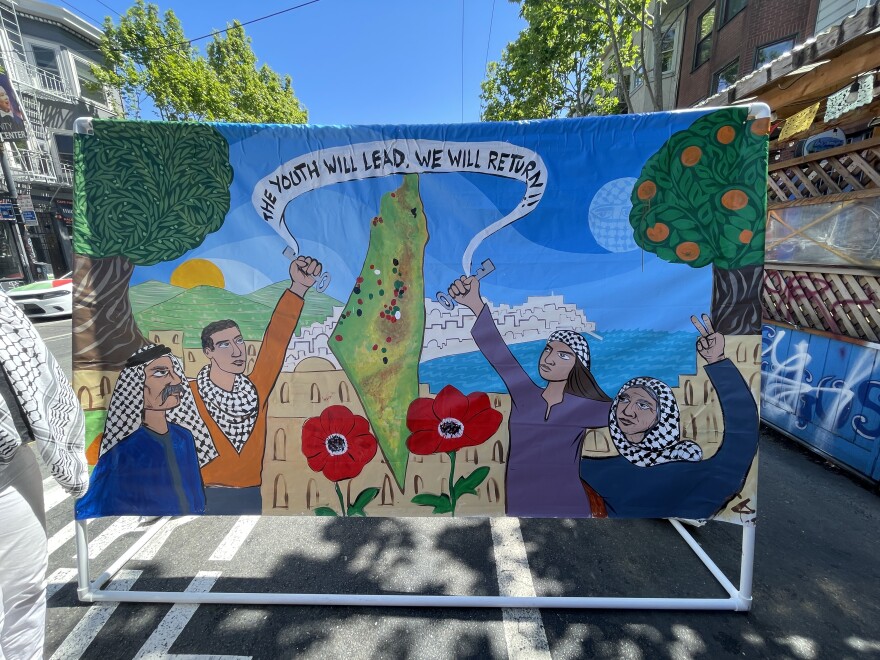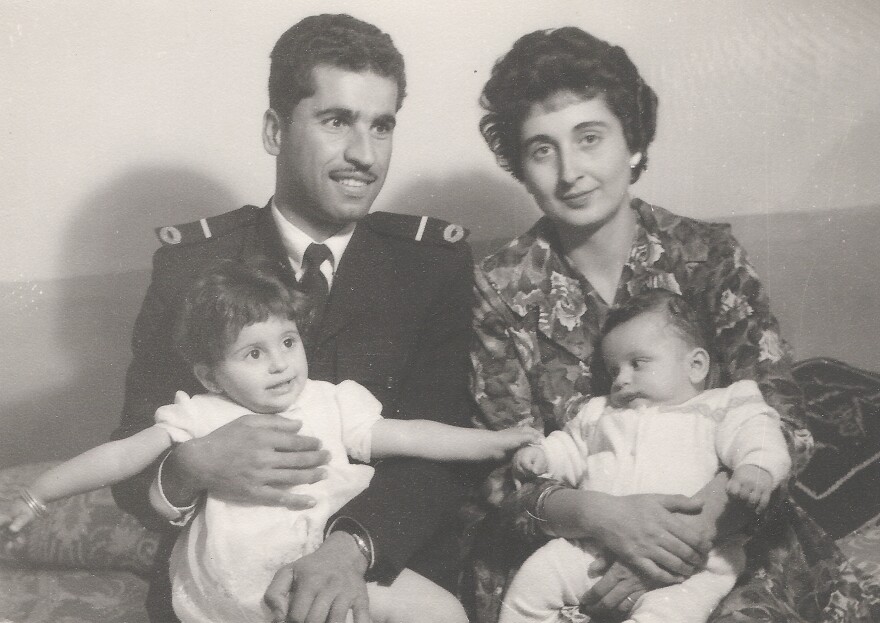"We don't have all the documentation of what happened during Nakba. They have been intentionally destroyed and the stories have been intentionally erased."Rama Ali Kased, Assistant Professor SFSU
This year marks 75 years since armed Zionist militias violently expelled more than 80% of Palestinians from their homes and established the state of Israel.
Some Palestinian families became internally displaced into refugee camps and neighboring towns inside of Palestine. Others became refugees in other countries. What they all have in common is that they survived the Nakba — meaning “catastrophe.”
Many Nakba survivors found their adopted home in the Bay Area. And three generations later, it hosts one of the most prominent communities in the country. To Palestinians — the Nakba never ended. The survivors, their children, and their grandchildren are still fighting to return home.
Story
It’s May 13th, 2023. I’m in the Mission District, walking towards a large Uhaul that’s blocking the street. Behind it, there’s a crowd of about 200 people. They’re chanting “Free Palestine '' and waving Palestinian flags.
One of today’s organizers is Diyala Shihadih. She describes the scene to me. “Right now we just finished marching through the Mission and we just stationed or parked on Valencia between 16th and 17th.”

She’s an activist with the Palestinian Youth Movement, a grassroots organization of young Palestinians living in the San Francisco Bay Area. She says people are gathered here to shed light on the ongoing violence against Palestinians.
She tells me that “a lot has escalated back home in Palestine. Gaza has just been hit by another round of missiles at the hands of the Zionist entity.”
This protest isn’t just to respond to the attacks. It’s also the 75th commemoration of the Nakba, which means catastrophe in Arabic. And Diyala’s grandfather, Yaser, is one of its survivors.
“I was born in Birzeit,” he tells me as we reminisce together in his family’s home in Millbrae. “It's a very nice country. Beautiful, mountainous, agricultural and everything.”
He can trace his family there for generations.
“It's my grandfathers and great, great, great grands. We have been living there since maybe 2000 years,” he explains.
When Yaser was thirteen, his family moved to a nearby town called Ramleh.
He was young, but he remembers that “it was very nice coastal city. At school I had very good friends and teachers.”
Then one day, in 1948, “a teacher of us, he made a speech.”
He warned Yaser and his classmates that trouble was coming, and to be prepared to sleep on the soil and only have the sky for cover.
Young Yaser understood immediately. “So this means we'll be in diaspora. And this what happened exactly like he told us. Yes. We packed up, we went back to Birzeit. My father’s job as a policeman was over.”
Yaser and his family weren’t alone.
Dr. Rama Ali Kased, assistant professor in Race and Resistance Studies at San Francisco State University, says that during the Nakba, most Palestinians who survived were forced to flee.
She explains that “over 750,000 Palestinians were displaced, over 400 villages were destroyed. Um, over 20 massacres occurred.”
And those numbers are based off the records that still exist.
“We don't have all the documentation of what happened during Nakba,” Dr. Kased tells me. “They have been intentionally destroyed and the stories have been intentionally erased.”
Overnight, Palestinian families were uprooted from the only homes they’d ever known.
According to Dr. Kased, “it didn't make sense to them. They were like, we are coming back home. This is a war. They're gonna fight this out and we're coming back home.”
Some people even left with the key to their home in their hands, thinking they’d need it to unlock their doors in the near future. Other families were displaced inside of Palestine like Yaser’s. They still had a home, but there was no way to make money.
“My father had no job. We had no income,” he remembers.
His family survived by living off the food they grew on their land, but there was nowhere to sell the crop.
“It was very tough, very tough.”

Faced with this impossible decision, Yaser’s mom and grandfather sold their olive trees to the local church to fund his high school education. But when he graduated, there weren’t any jobs- for anyone.
So Yaser left to work for the Port of Aqaba in neighboring Jordan. Diyala remembers her Sido, Arabic for grandfather, saying that he lived off food that he planted in a small garden. His earnings went back home.
She says that “he was sending most of his money back home to his family to support them. He'd only live off of a couple of dinars a month.”
A few years after Yaser left to Jordan, Dr. Kased says that Palestinians suffered a second catastrophe, known as the Naksa.
“In 1967 there was what they call the Arab Israeli War,” she explains. “By the end of that war, Israel had confiscated more land. And refugees who were once displaced in 1948- there was more displacement, but also the refugees were again for a second time displaced.”
By the time the war ended, Israel confiscated over four times more land, including what’s now known as the West Bank- where Yaser’s family lived in Birzeit.
Without hesitation, Yaser tells me “we were living under occupation. No matter what- it was an occupation.”
After the Naksa, Yaser’s family had to request permission from the Israeli military for him to come visit. Even then, he could only stay for a few weeks at a time.
Diyala remembers a story her Sido told her about a time he couldn’t see his family. “I remember him telling me that him and my grandma were almost separated. That was when the Palestinian ID’s were instituted and put in place and the borders were closed.”
When the Naksa started, Diyala’s grandmother was visiting family in Birzeit while Yaser and their children stayed in Jordan.
“They got word of war and that they were gonna close the borders. My grandpa told me he tried to cross the border, got caught and almost got killed trying to cross the border.”
He sent for his wife with someone who did get through, and she managed to sneak across the border into Jordan.
“They were able to be reunited, but because of that they were effectively living in exile, unable to ever return permanently because they don't have Palestinian IDs.”
A few years later, Yaser had the opportunity to move his family to the U.S. He took it so that his children could get an education. And they opened up a corner store in San Francisco’s Sunset District. Yaser’s daughter Maha was six years old when they moved to California.
Maha tells me that her parents “were working day and night so we were always upstairs. So my parents always had the store, the business below where we lived because both my parents had to open and close shop.”
While Yaser and his wife worked long hours at the corner store, Maha and her siblings went to school.
So a yellow bus would come and pick me up and take me to school,” she remembers. “That's all my parents knew at the time, you know?”
Yaser and his family were brand new to town,but they weren’t alone. Dr. Kased says that San Francisco was a big immigration hub for Palestinians who fled after the Nakba.
“People were coming here with the idea that they were gonna go back. Their social and cultural networks depended on each other.” She even tells me about “stories of families chipping in to help get the visa to help get the flight and then bring their family members out here.”
And that’s exactly what happened to Yaser.
Most of the Birzeitis are available in the area. We knew them before they came, or later. We, we are like a big family Birzeitis,” he says with a laugh.
Dr. Kased says that even through the process of getting settled in the U.S., Palestinians never forgot why they were here in the first place.
“They also were, not just socially and culturally, um, engaged, but they were also politically having conversations of what was happening in their homeland.”
In 1987, Yaser and his family joined the Birzeit society in order to have those conversations. They also had fun- Maha tells me it’s where she learned her village’s traditional line dance, called dabkeh.
And her daughter Diyala followed in her footsteps.
“All the Arab parties we went to always had dabkeh,” says Diyala. “It was always like this small group of men who would go up and I'm like, I wanna learn to do that. Like, why aren't more people up there? So I saw my mom doing dabkeh growing up. She'd be like one of the few women in like a line or a group of men. And I was like, I wanna be that!”
Diyala says growing up in the Bay Area, the condition of being Palestinian was always at the forefront.
She says “I grew up knowing that Palestine was occupied.”
She remembers “going out into the protests with my mom and my grandma and other family members and like being in the streets and yelling for Palestinian liberation. It's always been a big part of my life and who I am.”

She says the Bay Area also shaped her relationship to her homeland.
“The spirit of the Bay Area is very particular, she explains to me, “and I think it resonated with a lot of Palestinians as well.”
Diyala and her friends “grew up during the Hyphy movement. And that included a lot of rebellious spirit, a lot of freedom of expression.”
These days, Diyala is organizing community actions and commemorations while her Sido rests in his retirement. And she does it with her grandfather’s displacement in mind.
“In the same way my grandfather always remembers, he has always wanted to go back. In his heart, that is his home. That is the place he dreams of. His heart is there, you know?
She says that “him being there makes him happy, “between the trees on his land. He is a farmer at heart,” she tells me.

Yaser, who just turned 90, dreams of returning to his home permanently.
“If I have a chance to go back to Birzeit now, I will go forever. Yeah. That's my birth country.” He sighs and says, “if I have a chance to go back any time for good, I will.”
And he sees Diyala as carrying the torch on in the fight to one day, return home.
“I support her. If you don't fight for yourself, for your family, for your country, you are useless. That's what I think. Your country is yourself. We take it like this.”
Yaser, Maha and Diyala’s story is one of many among Bay Area Palestinians. Until a return to their homeland is possible, they’ll remember home, everyday, from here.
This story was made to be heard, click the play button above to listen
This story aired in the November 6, 2023 episode of Crosscurrents.



